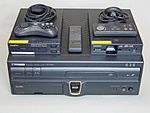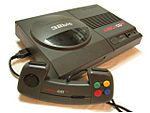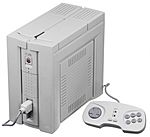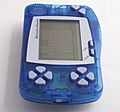History of video game consoles (fifth generation) facts for kids
The fifth generation of video game consoles began in 1993 and ended in 2002. The fifth generation was also called the 32-bit, 64-bit or the 3D generation of video game consoles. Throughout the fifth generation, only three consoles were among the most popular video game consoles in this era. These consoles include, the Sega Saturn (1994), the Sony PlayStation (1994), and the Nintendo 64 (1996). In different parts of the world, console sales varied widely. However, the PlayStation was the best-selling system of the fifth generation. The 3DO, Atari Jaguar, Amiga CD32 and PC-FX and other consoles were also part of this generation. However, those systems were not very successful.
The handheld game consoles of the fifth generation were not that successful. The first handheld, Sega Nomad had a lifespan of two years. The Virtual Boy only had less than one year. Both of them were discontinued. Nintendo's Game Boy Color became the best-selling handheld video console of the fifth generation. There were two updated versions of the original Game Boy such as the Game Boy Light (Japan only) and the Game Boy Pocket.
The bit ratings of consoles in the 5th generation began to blur & were less of a selling feature than the previous "bit wars" of the 8 and 16 bit era. The number of "bits" in console names referred to the CPU word size. It had been used by hardware marketers as a "show of power" for many years. The fifth generation saw the increase of emulation. The development of the Internet made it possible to save and download tape and ROM images of older games. This led the seventh generation consoles to make many older games available for purchase or download.
Contents
Home systems
Comparison
| Name | 3DO Interactive Multiplayer | Atari Jaguar | Sega Saturn | PlayStation | Nintendo 64 |
|---|---|---|---|---|---|
| Developer | The 3DO Company | Atari | Sega | Sony | Nintendo |
| Console |
|
|
|
|
|
| Launch prices (USD) | US$699.99 | US$249.99 | US$399.99 | US$299.99 | US$199 |
| Release date | NA October 4, 1993 JP March 20, 1994 EU 1994 |
NA November 15, 1993 JP November 21, 1994 EU Q4, 1994 |
JP November 22, 1994 NA May 11, 1995 EU July 8, 1995 |
3 December 1994 | JP June 23, 1996 NA September 29, 1996 EU March 1997 |
| Media | CD-ROM | Cartridge | CD-ROM, cartridge (limited, Japan only) | CD-ROM | Cartridge, (proprietary magnetic disk via Japan-only add-on) |
| Best-selling game | Virtua Fighter 2, 1.7 million in Japan | Gran Turismo, 10.85 million shipped (as of April 30, 2008) | Super Mario 64, 11.62 million (as of May 21, 2003) | ||
| CPU | ARM60 32-bit RISC CPU at 12.5 MHz | "Tom" (26.6 MHz), "Jerry" (26.6 MHz) and a Motorola 68000 (13.3 MHz) | Two Hitachi SuperH-2 7604 32-bit RISC processors at 28.63 MHz | MIPS R3000A-compatible 32-bit RISC chip running at 33.8688 MHz | NEC VR4300 64-bit at 93.75 MHz |
| GPU | Two accelerated video co-processors | 5 processors contained in 3 chips: "Tom", "Jerry" and Motorola 68000 | Two custom 32-bit video display processors at 28.63 MHz | 66 MIPS vector math unit in the main CPU | Reality Co-Processor: MIPS R4000-based 8-bit integer vector processor at 62.5 MHz |
| Memory | 2MB RAM, 1MB VRAM | 2 MB of fast page mode DRAM(4 chips x 512 KB) | 1MB SDRAM, 1MB DRAM, 6x 512KB for 3D graphics, 3D frame buffers, 2D graphics, sound, CD subsystem, BIOS ROM | 2MB, 1MB VRAM, 512KB sound | 4MB (8MB with Expansion Pak) |
| Accessories (retail) |
|
|
|
||
| System sales (worldwide) |
2 million |
500,000 |
9.4 million |
102 million |
32.93 million |
Other consoles
| Name | FM Towns Marty | Pioneer LaserActive | Amiga CD32 | Neo Geo CD | PC-FX | Apple Bandai Pippin |
|---|---|---|---|---|---|---|
| Developer | Fujitsu | Pioneer | Commodore | SNK | NEC | Apple |
| Console |
|
|
|
|
|
|
| Launch prices | US$450 | ¥89,800, US$970 | US$500 | US$300 | US$250 | US$599 |
| Release date | JP February 20, 1993 |
JP August 20, 1993 NA September 13, 1993 |
|
|||
| Media | CD-ROM, 3½-inch floppy disk | Laserdisc | CD-ROM | CD-ROM | CD-ROM | CD-ROM |
- Non-mass-market systems
Worldwide sales
| Console | Units sold |
|---|---|
| PlayStation | 102.49 million shipped (as of March 31, 2007) |
| Nintendo 64 | 32.93 million (as of March 31, 2005) |
| Sega Saturn | 9.4 million (as of May 4, 2007) |
| 3DO | 2 million (as of May 4, 2007) |
| Atari Jaguar | 500,000 (as of May 15, 2007) |
| Amiga CD32 | 100,000 |
| PC-FX | <100,000 |
| Apple Bandai Pippin | 42,000 (as of May 4, 2007) |
Handheld systems
-
Sega Nomad
Released in 1995 -
Virtual Boy
1995–1996 -
Game Boy Pocket
Released in 1996 -
Game Boy Light
Released in April, 1998 -
Game Boy Color
Released in November, 1998 -
WonderSwan
Released in 1999 -
WonderSwan Color
Released in 2000
Milestone titles
- Crash Bandicoot
- Dragon Warrior VII
- Final Fantasy VII
- Gran Turismo
- GoldenEye 007
- Star Fox 64
- The Legend of Zelda: Ocarina of Time
- Metal Gear Solid
- The Need for Speed
- Nights into Dreams...
- PaRappa the Rapper
- Perfect Dark
- Nintendo's Pokémon titles for the Game Boy
- Super Mario 64
- Resident Evil
- Silent Hill
- Spyro the Dragon
- Tomb Raider
Images for kids
-
FM Towns Marty, created by Fujitsu. Released on February 20, 1993.
-
Amiga CD32, created by Commodore. Released on September 17, 1993.
-
PC-FX, created by NEC. Released on December 23, 1994.
-
Playdia, created by Bandai. A console consisting of simple multiple choice games. Released in Japan on September 23, 1994, for ¥24,800.
-
Casio Loopy, created by Casio. Released in October 1995 in Japan, targeted at female gamers.
-
Genesis Nomad Released in 1995 in the U.S. only
-
Virtual Boy 1995–1996
-
Game Boy Color Released in November 1998
-
WonderSwan Released in 1999 in Japan only
-
WonderSwan Color Released in 2000 in Japan only
See also
 In Spanish: Videoconsolas de quinta generación para niños
In Spanish: Videoconsolas de quinta generación para niños








































